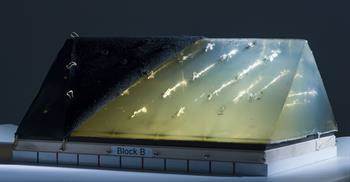Does a bullet deviate if shot through the human body?
Do bullets deviate if they are shot through a human body, but do not hit any bones? This is a question that may be essential to find out what exactly happened during a shooting incident. Firearm experts of the Netherlands Forensic Institute (NFI) are currently doing scientific research to get an answer to that question.
“If you investigate a crime scene following a shooting, you know one thing for sure: the victim is not in exactly the same position as when he or she was hit. The victim fell, may have run away, been taken to hospital or died in the meantime. Legally, however, it may be highly relevant to establish the exact location of the victim later on,” one of the researchers and firearm expert Wim Kerkhoff says.

Staircase
Forensic experts reconstruct the trajectory of a shot, among other things, on the basis of the bullet holes. Imagine, for example, that a bullet was shot through a door and finally ended in a wall. If you draw a line between these two points, you know the trajectory of the bullet.
If a person was standing in the trajectory of the bullet, it is possible to position this person by placing the entrance and/or exit in the body in the trajectory of the bullet.
Kerkhoff: “In our calculations, we always apply margins, of course, because we do not know what exactly the influence of the human body is on the trajectory of the bullet. That has never been researched scientifically. And that is exactly what we envision with this study. The results will enable us to determine the position of the victim much more accurately in the future.”
The firearm expert gives a fictitious example to explain this. “A fatal shooting incident in a staircase involves several persons. The trajectories of the bullets in the body of the victim run diagonally from top to toe. Does this prove that the victim was shot at from top to toe, as a witness states? Or could the slanting trajectories have been caused as a result of the fact that the trajectories of the bullets deviated in the body?”
Leather and gelatine
The NFI performed the first tests in cooperation with the University of Bern. “They have made substantial progress in the area of wound ballistics”, Kerkhoff explains. “We fired shots at blocks of gelatine covered with a specific type of leather. These are the best simulants for the human body and the skin.”
With the first tests, Kerkhoff and his colleagues wanted to find out to what extent the tests were influenced by using the gelatine blocks as simulants of the human body. “We examined whether the deviation of the bullets was directed if the bullets were fired just below the top of the block or just below the bottom. We also examined whether the deviation is directed if two bullets are fired right beside each other.”
126 shots give the answer
The answer to the question posed by Kerkhoff and the other researchers was clear. There is no influence. “We did see that bullets always deviate 6 to 7 degrees. With the help of forensic statistician Annabel Bolck, we examined to what extent it was possible to establish a pattern in the deviations. This was not the case. It does not make any difference whether you fire a shot just below the bottom or top of a block of gelatine, or right beside the track of a previous shot. The only thing we saw is that the trajectory of the bullet always changed.”
The results of this study have been published in a scientific article. But this does not mean the end of the study. “The block of gelatine we used was 25 centimetres thick and the bullets were calibre 9 millimetre Parabellum. This is the calibre most common in the Netherlands, and this is the calibre that is also used by the police. We currently only have data about this calibre alone, with a thickness of 25 centimetre of gelatine. We also have not tried yet what happens if you fire a bullet in the gelatine at an angle.”
The next few months, the firearm experts of the NFI will carry out experiments with other calibres and blocks of gelatine of various sizes.
“We hope to have completed these experiments before the summer, and to have processed its results in a scientific publication before the end of the year.”